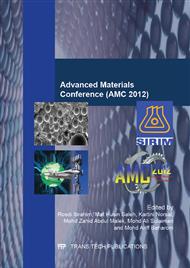p.21
p.27
p.32
p.38
p.43
p.51
p.58
p.63
p.73
Characterization of PM Fe-Cr-Y2O3 Composites Prepared by Microwave Sintering Technology
Abstract:
This research is focused on assessing the feasibility of the new and innovative microwave sintering technology for fabricating iron-chromium composites prepared via powder metallurgy route. Accordingly, the microwave sintered iron-chromium compacts was benchmarked against conventional sintered counterparts fabricated in other researches. We also studied the viability of yttria reinforcement to the iron-chromium composites with varying weight fraction from 5 to 20 %. Comparison on the end properties were also being made on the unreinforced iron-chromium matrix (0 wt. % of yttria). The result revealed that the microwave sintered iron-chromium composites possess improved density and micro hardness value. Process evaluation also revealed that microwave assisted sintering can lead to a reduction of 70 % of sintering time when compared to conventional sintering. The micro hardness property of microwave sintered iron-chromium was slightly improved with 5 wt. % addition of yttria, although the density and compressive strength were reduced with increasing content of the ceramic particulates. Most importantly, the study has established the viability of microwave sintering approach used in place of conventional sintering for iron based powder metallurgy composites.
Info:
Periodical:
Pages:
43-50
Citation:
Online since:
January 2014
Authors:
Keywords:
Price:
Сopyright:
© 2014 Trans Tech Publications Ltd. All Rights Reserved
Share:
Citation:


